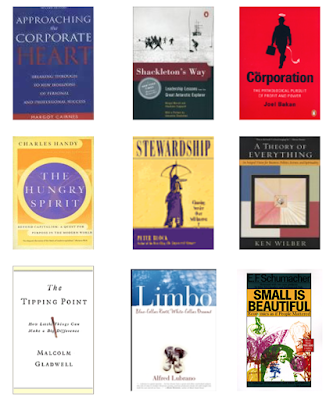We originally held Club 451 for six years between 15 June 2005 to November 2011. During that time we discussed (or rather became) over 40 book titles. Mostly, these were books we felt might inform a post-dystopian world. Through our common connection to leadership and management studies many of the books presented had that particular emphasis.
In having an opportunity to renew the format, we remembered why Club 451 had come into being to begin with. During the eight year hiatus since we last met it is as if the world has in fact forgotten how to read. Indeed we are at the conjunction of a strange set of societal dynamics. It was refreshing to meet once more to 'become a book' for a future world.
For historical reference, below is the original text of the (now archived) web-page (circa 2005) which described what Club 451 was (and how it worked).
The Context
Club 451 is a different sort of book club. You are invited to be part of a different way to think about books.
In Ray Bradbury's book he describes a future world where owning or reading a book is illegal. In this fictional society all books are banned and burned. Only those who are outside society cherish books for their wisdom. The rest of society fears them. Each of these outsiders holds within them a book and the wisdom it contains for a later day when someone will listen and when the world wants to know again. In the foothills at night these brave souls come together to share what they have read. Together they are a whole library of great thought.
Club 451 is created in the image of Ray Bradbury's fictional world.
The Idea
In most book clubs everyone reads the same book and all share their views and thoughts about that book. This may be about whether we like it or not. It may be about whether we like the way it is written. It may be whether we associate with the characters. We like books that challenge us. We also like those that affirm our view. And those views may be different. Ordinarily, what seems most important is not the views of the author, but our views on the author.
Club 451 has a different approach. In Club 451 one person reads the book. They become the book. Its wisdom, a true account, is held - just for one evening - by them. All others come to listen - and to discuss what they have heard about what the book actually says - with an open mind.
"Would you like, some day, Montag, to read Plato's Republic?"
'Of Course!'
"I am Plato''
'Like to read Marcus Aurelius?'
'Mr Simmons is Marcus'
'How do you do?' said Mr Simmons
'Hello' said Montag.
~ Fahrenheit 451
When we come together at Club 451 instead of being one book, we are together a library of all the books we have ever read.
The Format
The format respects the written work.
Each month a small group making up our Club 451 get together. One person has nominated at the previous month's meeting to be the book for that evening. They host the evening, organize the venue, welcome everyone and make sure all are comfortable. We take it in turns to do this. Everyone gets to be a book.
The host begins simply by reciting the book's author, title, the dedication in the front of the book (if any) and then reads aloud the first page (or so). This gives all those present a feel for the author's voice. The host then informally describes the book in its entirety, being true to the author's text, quoting where necessary, without comment if possible.
When the host has described the book, the host opens the forum up for discussion. The rest gathered then question the reader about the book and its content, not for their views of what was said - but to discover and hold what the author said. The viewing of the speaking becomes a new seeing.
When the idea of the book is understood by all, the host may then share their views on what the book is saying to them and others share their views of what the essence of the book described says to them.
The conversation should eventually drift away from the book itself and conclude with what the book holds that is valuable to our society in the future.
A Club 451 gathering informally concludes when the conversation suggests another book that all would like to have read (but may not have had the time to). Someone offers to be that book for the next month ... and so on.
The Reason
There are millions of books to read in a lifetime. How will you get time to read them all?
The knowledge we hold, we need to collectively share, for it is this knowledge that builds societies. It is this knowledge we are losing.
Ray Bradbury's world of the future in 1953 has many likenesses to our world of the present. TV walls entrance those who stay inside hiding from 'the pores of the face of life'. Prescription drugs dull the pain of the live coverage of local and distant events provided as reality info-tainment shows. Welcomed home by the virtual 'family', there is no reason to experience the 'real' world.
"The Televisor is real. It is immediate, it has dimension. It rushes so quickly to its conclusions your mind hasn't time to protest. It tells you what to think and blasts it in. It must be right. It seems so right. It is an environment as real as the world. It becomes and is the truth." ~ Fahrenheit 451
In this fictional world of instantly transmitted mass reality and ratings journalism wisdom, there is no room for books and thinking. This fictional society has stopped being able to find the knowledge in books, finding instead only their own fiction. Somewhere along the line they lost the ability to truly read and hear the author - and as a result they lost the books they already had.
The Three Things
Ray Bradbury's character Faber answers the question 'Why books?' and goes on to tell us what is missing from his society:
"Three things are missing... Number one, as I said, quality of information. Number two: leisure to digest it. And Number three: the right to carry out actions based on what we learn from the interaction of the first two." - Fahrenheit 451
Club 451 brings these missing parts together.
The Three Perspectives
Club 451 also introduces an integral-postmetaphysics (Wilber, 2005) praxis to bookclubs.
The name itself refers to the process of bringing to the discussion (consciously) three different perspectives in sequence, being:
4th person perspective ~ personally appreciating the view by the author expressed in his or her own work;
5th person perspective ~ collectively discerning a situated perspective on the various perspectives of the author by the work;
1st person perspective ~ each member integrating a personal perspective on the work as perceived.
In this way, each book is viewed from at least three perspectives, by multiple agents, expanding our appreciation and providing for the potential for integration of the wider span of views of those present (as well as those presenting).
The Invitation
You are invited to join Club 451 and form your own group. Here are some of the books we have already become:
The Books:
1. Fahrenheit 451 – Ray Bradbury
2. Hero With A Thousand Faces – Joseph Campbell
3. Pattern Recognition - William Gibson
4. Presence – Otto Scharmer
5. Approaching the Corporate Heart – Margot Cairnes
6. Shackleton’s Way – Margaret Morell
7. The Corporation – Joel Bakan
8. The Hungry Spirit – Charles Handy
9. Stewardship – Peter Block
10. A Theory of Everything – Ken Wilber
11. The Tipping Point – Malcolm Gladwell
12. Limbo – Alfred Lubrano
13. Small is Beautiful – Ernst Schumacher
14. The Never Ending Quest – Clare Graves
15. How the Way We Talk Can Change the Way We Work – Robert Kegan and Lisa Lahey
16. Flight of the Creative Class – Richard Florida
17. Island - Aldous Huxley
18. The Demon Haunted World – Carl Sagan
19. The Four Hour Work Week – Tim Ferris
20. Atlas Shrugged – Ayn Rand
21. A New Science of Life – Rupert Sheldrake
22. The Five Literacies of Global Leadership – Richard Hames
23. Sex Ecology and Spirituality – Ken Wilber
24. A New Earth – Eckhart Tolle
25. The Freedom Paradox – Clive Hamilton
26. Ask and It is Given – Ester and Jerry Hicks
27. The Structure of Scientific Revolutions – Thomas Kuhn
28. Nature and the Human Soul – Bill Plotkin
29. Stranger in a Strange Land – Robert Heinlein
30. Bustin’ Loose – Robert Scheinfeld
31. The Journey of Socrates – Dan Millman
32. Generation X – Douglas Coupland
33. The Ninth Wave - Eugene Burdick
34. Normal Breath - Artour Rakhimov
35. Waking the Global Heart - Anodea Judith
36. Underworld – Graham Handcock
37. The Management Myth – Matthew Stewart
38. Ripples from the Zambesi – Ernesto Sirolli
39. Journey to the East – Herman Hesse
40. A Hidden Wholeness - Parker Palmer
41. The Madness of Crowds - Douglas Murray
"Books were only one type of receptacle where we stored lots of things we were afraid we might forget. There is nothing magical in them at all. The magic is only in what the books say, how they stitched the patches of the universe together into one garment for us." ~ Fahrenheit 451
























